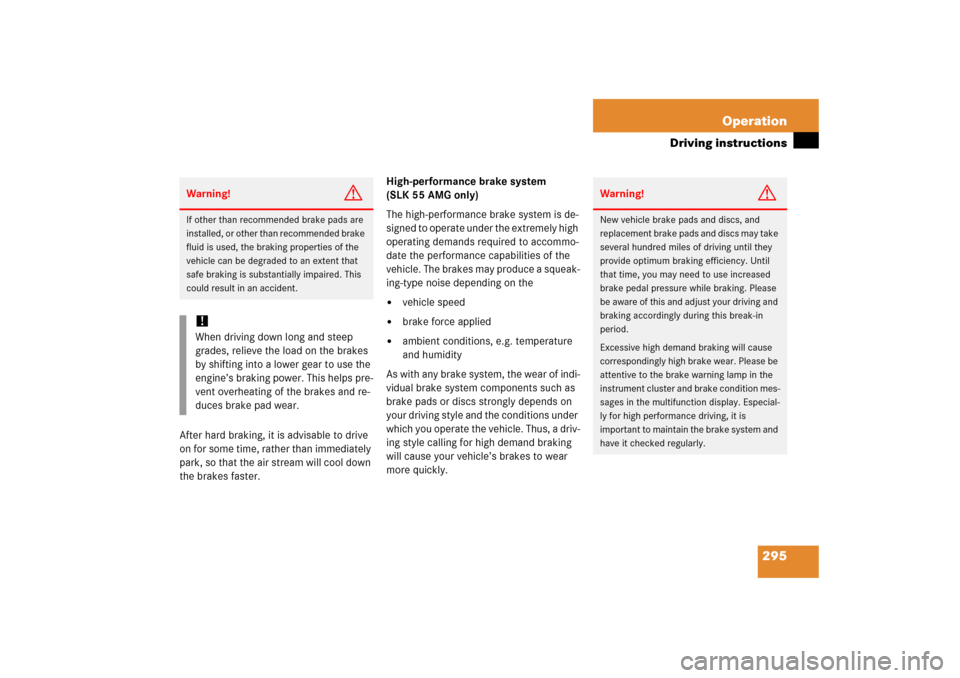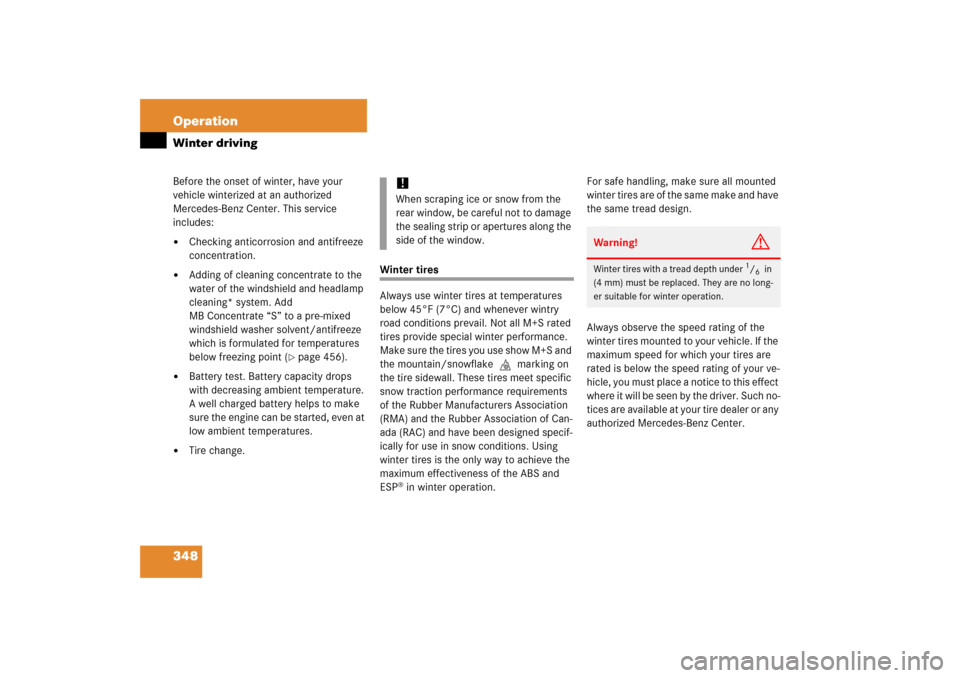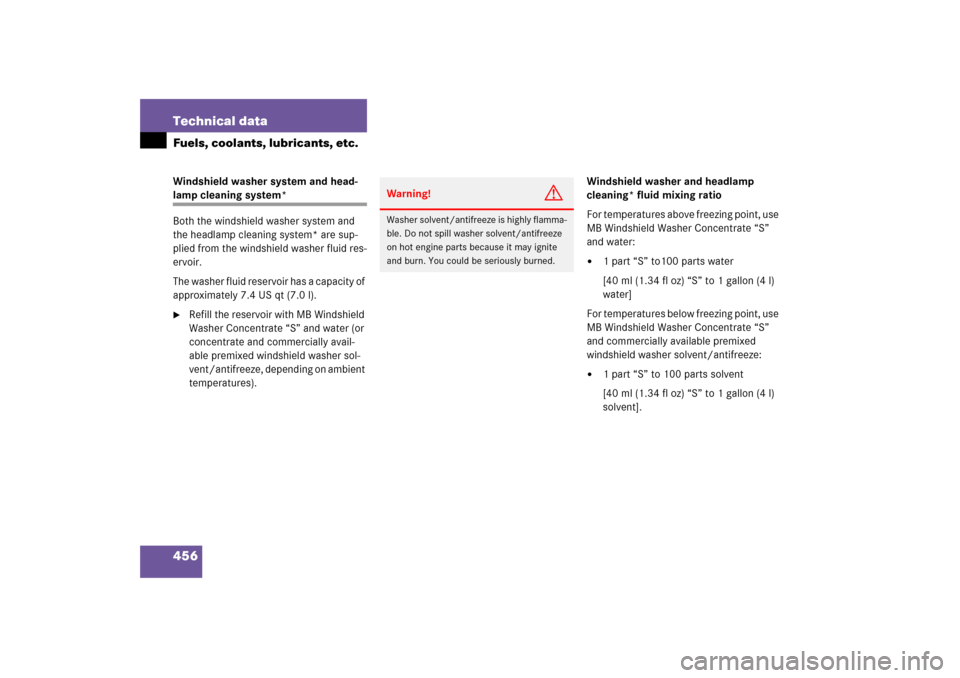Page 296 of 481

295 Operation
Driving instructions
After hard braking, it is advisable to drive
on for some time, rather than immediately
park, so that the air stream will cool down
the brakes faster.High-performance brake system
(SLK 55 AMG only)
The high-performance brake system is de-
signed to operate under the extremely high
operating demands required to accommo-
date the performance capabilities of the
vehicle. The brakes may produce a squeak-
ing-type noise depending on the
�
vehicle speed
�
brake force applied
�
ambient conditions, e.g. temperature
and humidity
As with any brake system, the wear of indi-
vidual brake system components such as
brake pads or discs strongly depends on
your driving style and the conditions under
which you operate the vehicle. Thus, a driv-
ing style calling for high demand braking
will cause your vehicle’s brakes to wear
more quickly.
Warning!
G
If other than recommended brake pads are
installed, or other than recommended brake
fluid is used, the braking properties of the
vehicle can be degraded to an extent that
safe braking is substantially impaired. This
could result in an accident.!When driving down long and steep
grades, relieve the load on the brakes
by shifting into a lower gear to use the
engine’s braking power. This helps pre-
vent overheating of the brakes and re-
duces brake pad wear.
Warning!
G
New vehicle brake pads and discs, and
replacement brake pads and discs may take
several hundred miles of driving until they
provide optimum braking efficiency. Until
that time, you may need to use increased
brake pedal pressure while braking. Please
be aware of this and adjust your driving and
braking accordingly during this break-in
period.
Excessive high demand braking will cause
correspondingly high brake wear. Please be
attentive to the brake warning lamp in the
instrument cluster and brake condition mes-
sages in the multifunction display. Especial-
ly for high performance driving, it is
important to maintain the brake system and
have it checked regularly.
Page 298 of 481

297 Operation
Driving instructions
Tires
Treadwear indicators (TWI) are required by
law. These indicators are located in six
places on the tread circumference and be-
come visible at a tread depth of approxi-
mately
1/16
in (1.6 mm), at which point
the tire is considered worn and should be
replaced.The treadwear indicator appears as a solid
band across the tread.
Specified tire inflation pressures must be
maintained. This applies particularly if the
tires are subject to high loads (e.g. high
speeds, heavy loads, high ambient temper-
atures).
Hydroplaning
Depending on the depth of the water layer
on the road, hydroplaning may occur, even
at low speeds and with new tires. Reduce
vehicle speed, avoid track grooves in the
road and apply brakes cautiously in the
rain.
Warning!
G
If you feel a sudden significant vibration or
ride disturbance, or you suspect that possi-
ble damage to your vehicle has occurred,
you should turn on the hazard warning flash-
ers, carefully slow down, and drive with cau-
tion to an area which is a safe distance from
the road.
Inspect the tires and the vehicle undercar-
riage for possible damage. If the vehicle or
tires appear unsafe, have the vehicle towed
to the nearest Mercedes-Benz Center or tire
dealer for repairs.
Warning!
G
Although the applicable federal motor vehi-
cle safety laws consider a tire to be worn
when the treadwear indicators (TWI) be-
come visible at approximately
1/16in
(1.6 mm), we recommend that you do not al-
low your tires to wear down to that level. As
tread depth approaches
1/8in (3.0 mm),
the adhesion properties on a wet road are
sharply reduced.
Depending upon the weather and/or road
surface (conditions), the tire traction varies
widely.
Warning!
G
Do not drive with a flat tire. A flat tire affects
the ability to steer or brake the vehicle. You
may lose control of the vehicle. Continued
driving with a flat tire or driving at high
speed with a flat tire will cause excessive
heat build-up and possibly a fire.
Page 317 of 481

316 OperationEngine compartmentDuring all seasons, add MB Windshield
Washer Concentrate “S” to water. Premix
the windshield washer fluid in a suitable
container.
�
Pull cap upward using latch until it
opens.
�
Refill the reservoir with MB Windshield
Washer Concentrate and water (or
commercially available premixed wind-
shield washer solvent/antifreeze, de-
pending on ambient temperatures).
Always use washer solvent/antifreeze
where temperatures may fall below
freezing point. Failure to do so could re-
sult in damage to the washer sys-
tem/reservoir.
�
Push cap down until it engages.For more information, see “Windshield
washer system and headlamp cleaning
system*” (
�page 456).
Warning!
G
Washer solvent/antifreeze is highly flamma-
ble. Do not spill washer solvent/antifreeze
on hot engine parts, because it may ignite
and burn. You could be seriously burned.
!Only use washer fluid which is suitable
for plastic lenses. Improper washer flu-
id can damage the plastic lenses of the
headlamps.
Page 349 of 481

348 OperationWinter drivingBefore the onset of winter, have your
vehicle winterized at an authorized
Mercedes-Benz Center. This service
includes:�
Checking anticorrosion and antifreeze
concentration.
�
Adding of cleaning concentrate to the
water of the windshield and headlamp
cleaning* system. Add
MB Concentrate “S” to a pre-mixed
windshield washer solvent/antifreeze
which is formulated for temperatures
below freezing point (
�page 456).
�
Battery test. Battery capacity drops
with decreasing ambient temperature.
A well charged battery helps to make
sure the engine can be started, even at
low ambient temperatures.
�
Tire change.
Winter tires
Always use winter tires at temperatures
below 45°F (7°C) and whenever wintry
road conditions prevail. Not all M+S rated
tires provide special winter performance.
Make sure the tires you use show M+S and
the mountain/snowflake.marking on
the tire sidewall. These tires meet specific
snow traction performance requirements
of the Rubber Manufacturers Association
(RMA) and the Rubber Association of Can-
ada (RAC) and have been designed specif-
ically for use in snow conditions. Using
winter tires is the only way to achieve the
maximum effectiveness of the ABS and
ESP
® in winter operation.For safe handling, make sure all mounted
winter tires are of the same make and have
the same tread design.
Always observe the speed rating of the
winter tires mounted to your vehicle. If the
maximum speed for which your tires are
rated is below the speed rating of your ve-
hicle, you must place a notice to this effect
where it will be seen by the driver. Such no-
tices are available at your tire dealer or any
authorized Mercedes-Benz Center.!When scraping ice or snow from the
rear window, be careful not to damage
the sealing strip or apertures along the
side of the window.
Warning!
G
Winter tires with a tread depth under
1/6 in
(4 mm) must be replaced. They are no long-
er suitable for winter operation.
Page 409 of 481
408 Practical hintsFlat tireThe SLK 55 AMG with Performance
Package* is equipped with a TIREFIT kit.Preparing the vehicle�
Park the vehicle as far as possible from
moving traffic on a hard surface.
�
Turn on the hazard warning flashers.
�
Turn the steering wheel so that the
front wheels are in a straight ahead po-
sition.
�
Set the parking brake (
�page 52).
�
Move the gear selector lever* toP
(manual transmission to first or reverse
gear).
�
Turn off the engine (
�page 61).
�
Remove the SmartKey from the starter
switch.
�
Have any passenger exit the vehicle at
a safe distance from the roadway.
Sealing tires with TIREFIT
Small tire punctures, particularly those in
the tread, can be sealed with TIREFIT.
TIREFIT can be used in ambient tempera-
tures down to -4°F (-20°C).
iOpen door only when conditions are
safe to do so.
iSLK 55 AMG with Performance
Package* only.Warning!
G
Keep TIREFIT away from sparks, open flame
or heat source.
Do not smoke.
Page 457 of 481

456 Technical dataFuels, coolants, lubricants, etc.Windshield washer system and head-lamp cleaning system*
Both the windshield washer system and
the headlamp cleaning system* are sup-
plied from the windshield washer fluid res-
ervoir.
The washer fluid reservoir has a capacity of
approximately 7.4 US qt (7.0 l).�
Refill the reservoir with MB Windshield
Washer Concentrate “S” and water (or
concentrate and commercially avail-
able premixed windshield washer sol-
vent/antifreeze, depending on ambient
temperatures).Windshield washer and headlamp
cleaning* fluid mixing ratio
For temperatures above freezing point, use
MB Windshield Washer Concentrate “S”
and water:
�
1 part “S” to100 parts water
[40 ml (1.34 fl oz) “S” to 1 gallon (4 l)
water]
For temperatures below freezing point, use
MB Windshield Washer Concentrate “S”
and commercially available premixed
windshield washer solvent/antifreeze:
�
1 part “S” to 100 parts solvent
[40 ml (1.34 fl oz) “S” to 1 gallon (4 l)
solvent].
Warning!
G
Washer solvent/antifreeze is highly flamma-
ble. Do not spill washer solvent/antifreeze
on hot engine parts because it may ignite
and burn. You could be seriously burned.